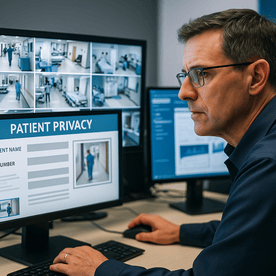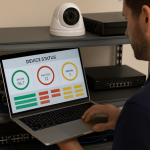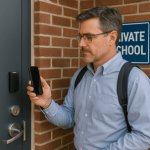
Video surveillance has long been a cornerstone of hospital security. From monitoring entrances to safeguarding sensitive areas, cameras play a critical role in keeping patients, staff, and visitors safe. But as AI-powered video analytics becomes more common, hospitals face a critical challenge: How can you leverage advanced surveillance without violating patient privacy or HIPAA regulations?
It’s a fine line. Hospitals need real-time insights from security systems, yet they also must protect the confidentiality of patients receiving care. Let’s explore what HIPAA-compliant surveillance really means in 2025, how analytics fit in, and what healthcare administrators should look for when upgrading systems.
k
k
Why HIPAA Compliance Matters for Video Analytics
The Health Insurance Portability and Accountability Act (HIPAA) doesn’t prohibit the use of video surveillance in healthcare facilities. However, it does require strict safeguards for any footage that could be tied to a patient’s identity or medical information.
This means:
-
Surveillance data must be secured from unauthorized access.
-
Only approved staff should view video feeds containing patient activity.
-
Retention policies must be documented and followed.
-
Audit logs are required to track who accessed video and when.
If video analytics are introduced without compliance in mind, hospitals risk fines, reputational damage, and, most importantly, the trust of their patients.
k
k
How Video Analytics Helps Hospital Security
When properly implemented, video analytics can actually strengthen security and operational efficiency while reducing manual workload. Common use cases include:
-
Detecting unusual movement or loitering in sensitive areas like NICUs, pharmacies, or data centers.
-
Recognizing tailgating at access-controlled doors and alerting staff.
-
Monitoring crowd density in waiting rooms or emergency departments to improve patient flow.
-
Triggering real-time alerts for aggressive behavior, helping prevent workplace violence.
Instead of asking staff to watch hours of camera footage, analytics provides smart alerts that focus attention where it’s needed most.
k
k
Making Video Analytics HIPAA-Compliant
Here’s where hospitals need to be careful. Video analytics can absolutely be compliant—but only when paired with the right safeguards.
1. Data Encryption and Secure Storage
All footage and analytics data should be encrypted both in transit and at rest. Cloud-based video systems must meet HIPAA security standards.
2. Role-Based Access Controls
Limit who can access video feeds and analytics results. For example, a nurse manager doesn’t need to view full surveillance footage from every unit, but security officers do.
3. Privacy Masking Features
Modern systems allow administrators to blur or mask patient areas (such as beds in treatment rooms) while still capturing relevant security events.
4. Audit Trails
Every access, export, or review of video must be logged. This ensures accountability and supports Joint Commission or HIPAA audits.
5. Retention Policies
Hospitals should define how long video is stored—balancing operational needs, compliance requirements, and storage costs.
k
k
Balancing Privacy and Security in Real Life
Imagine this scenario:
A patient in a behavioral health unit attempts to elope. Video analytics detect movement near an exit, alert security, and automatically link the event to nearby cameras. Staff respond within seconds, preventing harm.
At the same time, the system is configured to mask patient faces in live feeds shown outside the unit, ensuring only authorized caregivers have full visibility. This is a prime example of technology that is both effective and compliant.
k
k
What to Look for When Choosing a HIPAA-Compliant Video Analytics System
When evaluating vendors, ask:
-
Does the system include encryption, role-based access, and audit logging?
-
Can it integrate with access control and visitor management systems?
-
Does it offer privacy features like masking or redaction tools?
-
How does it handle cloud storage and disaster recovery?
-
Can it scale across multi-campus hospital networks?
A solution that meets these criteria ensures your investment is both future-ready and compliant.
k
k
Conclusion
Video analytics is no longer a luxury in hospital security—it’s becoming essential. But as hospitals adopt smarter surveillance, HIPAA compliance must guide every step of the process. By selecting platforms with built-in safeguards and pairing them with clear policies, healthcare leaders can have the best of both worlds: advanced security that never compromises patient trust.
Talk to SSP about implementing HIPAA-compliant video analytics that strengthens your hospital’s security while keeping privacy front and center.


